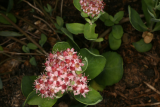Additional notes (click to expand)
Commemorative
Named after Telephus the son of Hercules.
Oakeley, Dr. Henry F. (2013). Wellcome Library notes.
link
Medicinal
Culpeper: ‘Crassula. Orpine. ... Outwardly, used with vinegar it clears the skin, inwardly taken, it helps gnawings of the stomach and bowels, ulcers in the lungs, bloody flux and Quinsy in the throat: for which last disease, it is inferior to none. Take not too much of it ...’
Culpeper, N. (1652). The English Physitian. London.
Notes: The Plants for a Future database www.pfaf.org reports: ‘The whole plant is astringent and cytostatic. It is a popular remedy for diarrhoea, stimulates the kidneys and has a reputation in the treatment of cancer. A poultice of the crushed leaves has been used in the treatment of boils and carbuncles.’ Named after Telephus, the son of Hercules.
Plants for a Future (2010) (http://www.pfaf.org/)
Nomenclature
OTHE COMMON NAMES: ALPINE LIVE-LONG; FROG'S STOMACH; HARPING JOHNNY; LIFE-EVERLASTING; LIVE-FOR-EVER; LIVELONG; MIDSUMMER MEN; ORPHAN JOHN; STONE-HOT; WITCH'S MONEYBAGS
The Royal Horticultural Society Horticultural Database, available at www.rhs.org.uk
Hylotelephium telephium (L.)H.Ohba previously Sedum telephium L. Crassulaceae. Orpine, Stonecrop. Culpeper (1650) calls it Crassula. Orpine. Named after Telephus, the son of Hercules (Stearn, 1994). Lyte calls it Crassula minor, Orpyne, Faba crassa, Fabaria, He also calls it Crassula major, Wild Prickmadam, and Sedum mlnor, Stone Hore.
Culpeper, Nicholas. (1650). A Physical Directory . London, Peter Cole.
Other use
Hylotelephium telephium (L.)H.Ohba previously Sedum telephium L. Crassulaceae. Orpine, Stonecrop. Succulent herb. Distribution: UK to Japan. Culpeper (1650) writes: ‘Crassula. Orpine. ... Outwardly, used with vinegar it clears the skin, inwardly taken, it helps gnawings of the stomach and bowels, ulcers in the lungs, bloody flux and Quinsy in the throat: for which last disease, it is inferior to none. Take not too much of it ...’ Named after Telephus, the son of Hercules (Stearn, 1994). Lyte calls it Crassula minor, Orpyne, Faba crassa, Fabaria, and says its use is the same as a Houseleek or Syngreene. The latter are Sempervivum species - the name derived from the Anglo-Saxon singrene meaning 'always green', referring to the fact that it stays green even when not in the earth. Apropos Sempervivum, he describes the redness and blistering that the sap has on bare skin, and how it is good for poisons, for if taken with vinegar by mouth it causes vomiting, but only safe to do so in strong people. He tries to distinguish Stonecrops [Sedum], which he also calls Crassula major, Wild Prickmadam, and Sedum mlnor, Stone Hore, from Sengreene for he advises the latter (i.e. Sedum), alone or mixed with barley meal, applied topically to burns, scalds, St Anthony's fire [erysipelas], ulcers and sores, to cure them and for sore eyes. Not approved by the European Medicines Agency for Traditional Herbal Medicinal use.
Oakeley, Dr. Henry F. (2013). Wellcome Library notes.
link
Sedum telephium L.
Family: CRASSULACEAEGenus: Sedum
Species: telephium L.
Common names: Orpine
Pharmacopoeia Londinensis name: Telaphium
Distribution summary: Europe to Japan
Habit: Perennial
Hardiness: H4 - Hardy; average winter
Habitat: Deciduous forests, damp, shady spots
Garden status: Not currently grown
Flowering months: June, July, August
Reason for growing: Medicinal
